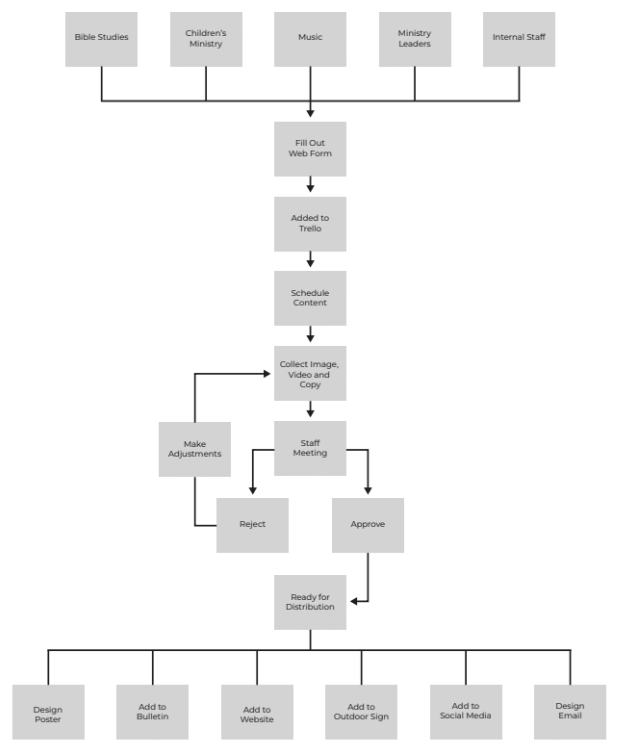
Defining Content Production Pipelines for Your Creative Team
So, what exactly is a content production pipeline? It is the order in which you publish and distribute your content. It is the workflow you define for your business and then assign to your team, so it is disseminated and tracked everywhere you possibly can.
You will only need to define your content production pipeline once but will use this same process every time you publish a new piece of content. Your team will know how to support you because it will be defined and you will save your sanity because you don’t have to do it all.
Defining this pipeline is essential to making sure you share your content on every platform. For example, you want to take any content that you publish to your website, but if you aren’t sharing it on your social media channels your audience on those platforms won’t get to see it.
Or if you end up publishing a deal on your social media page, but not developing a landing page to secure that deal on your website, it might be harder to track and those who go to your website will miss out!
Here is an example of a content production pipeline that could be used for a company that wanted to focus on written content.

First, team roles
Survey all of your team members, and ask them what parts of the content production pipeline they work on, and map it out. Jot down who:
- Comes up with the ideas
- Writes articles
- Copy edits
- Updates website content
- Takes photos
- Designs print materials
- Shoots and edits video
- Publishes social media content
This map will give you a better understanding of where your team’s energy is focused. It will give you insight as to how to direct them in the future.
Now: Define your own content production pipeline
Let’s determine what your content production pipeline looks like!
Grab a sheet of paper and jot down your own 12-15 steps that are required to get a piece of content out to the world. Imagine you are filling in the boxes on the chart above.
Where do you begin generating ideas?
What would your ideal work flow be to ensure your content is getting out everywhere with a system that will run smoothly time and time again?
Once you have come up with the steps of your own content production pipeline, take it to your team to cross check any steps that may need to be added.
Start with ideation or topic ideas and end with archiving or monthly reporting to circle back on what is working and what missed the mark.
Once you’ve defined your content production pipeline you won’t have to create it again, but continue to use it as a guide to walk you and your team through the process.
Here is an example of a bullet point content production pipeline:
- Brainstorm content ideas with team
- Outline talking points in Google Doc
- Record video
- Upload files for editor
- Review and approve
- Send to Rev to transcribe
- Edit down into short clips for social
- Post audio to Anchor.FM for podcast
- Post all to website
- Schedule posts on HeroPost
- Analyze results
It doesn’t have to be fancy, just functional!
Make it once and put it EVERYWHERE
The beauty of a content production pipeline is that once you create something, it won’t be a one-trick pony. When you publish an article, helpful graphic, or how to tutorial, you will have a plan for how to customize the delivery message for every platform audience you speak to. The way you tweet is very different from the way you address your monthly newsletter followers. You need to nuance messaging in order to penetrate your distinct audiences’ attention, but the concepts can be the same.
You also want to consider the different ways people consume information. Some people like video, some prefer to listen to podcasts and audiobooks, others read books and articles.
Experiment with how you create and deliver content. Track how a written blurb engages your audiences compared to a photo with text over it, or the way a video tutorial is received alongside the same content crafted as a how to article. There is no one silver bullet here. It all depends on how your audience likes to receive your content.
Track your content production projects using a project management platform
The content production pipeline system can easily be applied to any company in any industry. It’s versatile enough to use for general YouTube channels, order fulfillment, and businesses of all shapes and sizes. Whether you’re flying solo or have a large team at your back you can benefit from using these tools to help you streamline workflow processes within your business.
Project management platforms like Trello, ClickUp, Airtable and Asana allow for cross-team, internal workflow organization day-to-day.
Within these platforms, users can create “project boards” where they share assets, communicate with their teammates, and organize the status of their projects visually in a plethora of ways. For a content production pipeline, a column-oriented setup might work best, running chronologically from left to right, from ideation to creation to publication, each column denoting a different step. Users complete their task for each card and move it forward right down the line. It’s a visual way to project manage.
You can also write checklists, assign tasks and due dates, and communicate with clients on these platforms.
Some tips for your content production
Thumbnails: We use images for the thumbnail on YouTube, images for our blog posts, and social media. You can use a free program such as Canva to create Instagram posts, book covers, YouTube thumbnails and so much more. This is another great tool you need to be utilizing early and often in your business when it comes to consistent content creation.
Each thumbnail needs to be eye-catching, clickable, enticing. Be sure the photo is a clear picture with someone looking into and facing the camera. You want eye contact and a smile if possible in this still. It should be something that captures your audience and makes them feel invited to click on the image to learn more about the video.
Written copy: The written description of the video or transcript of the episode can be used for blog posts and social media posts, giving us a plethora of content from just one day of production work.
Scheduling upcoming content: In an ideal world, you are developing a pipeline of content in advance that you can schedule out in advance. Hopefully you even align your content with the calendar year (for example, Holiday Gift Guide, or Father’s Day Sale, or Valentine’s Day Sale, or Superbowl, March Madness or Kentucky Derby).
Whether it’s your website, email software, or social media, there are ways to frontload your content and schedule the date and time it is published. This means you can produce more when you’re in your slower times of the month and have that ready during the busy times of month— or when you want to go on vacation.
Distributing to social media: When the content is finalized, it goes to the publication person within the project management system – whoever it is that is responsible for publishing the content across websites, social media, and email automations. Learn how to strategize your release schedule and leverage social media management software in our guide to crafting a content calendar.
Download a copy of our free team marketing worksheets here. Want to learn even more? Check out our book and video course, Unify Your Marketing.